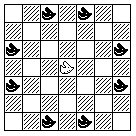
Many inventors of chess variants have viewed their innovations as being the natural succesor to the existing game of Chess. But these innovations have only sank into obscurity, while Chess in its familiar form continues on.
On these pages, I have presented quite a large selection of chess variants of my own invention. Now, I've decided to crystallize the ideas I have played with into a form that might reasonably be thought of as something that might attract wider interest.
A set for this game would consist of:
A checkered board for playing Chess, 12 squares across, and 8 squares deep.
For each of the two colors, White and Black, the following complement of pieces:
Twelve Pawns.
Two Rooks, two Knights, two Bishops, a King and a Queen.
Two Camels, which move by jumping to a square that is displaced from its starting square by three units in one orthogonal direction, and one unit in another perpendicular orthogonal direction. That is, it has a jump like that of a Knight, but one square more elongated.

This is the diagram of its move, as it appeared on the page about Leaping Bat Chess, so many pages ago.
Two Giraffes, which have a move like that of the Knight, but now elongated by two squares.
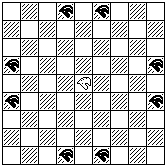
One Princess, which has the same power of movement as both the Knight and the Bishop.
One Empress, which has the same power of movement as both the Knight and the Rook.
One Cannon, which moves like a Rook, and which captures along orthogonal Rook lines, but only after jumping over exactly one other man which may be of either color; this is the move of the Cannon in Chinese Chess.
Two Tigers, which move, but not capture, as Bishops, and which capture, but not move without capturing, as Knights.
One Man, which moves by one square either orthogonally or diagonally, like a King, but which does not castle, and which is just another ordinary piece which may be captured without ending the game.
One Griffin, the move of which consists of one diagonal step, followed by any number of orthogonal steps from two upwards (so that it cannot move one space diagonally, or duplicate the move of the Knight) as illustrated below:

This gives each player twelve Pawns, and nineteen other pieces. But of those other pieces, only twelve of them can be used at once; so these pieces are used for four different variants of Chess:
First is the variant which would be the most similar to Chess as it is played today:
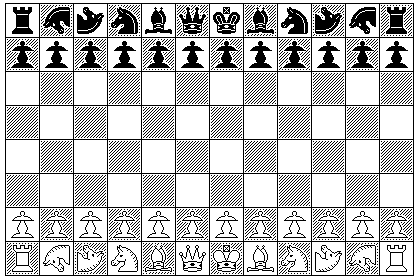
The arrangement of pieces in the last row is:
Rook, Giraffe, Camel, Knight, Bishop, Queen, King, Bishop, Knight, Camel, Giraffe, Rook
One may be forgiven for thinking that here the new pieces, the Camel and Giraffe, are just padding, thrown in so that a game similar to Chess may be played on the same 12 by 8 board as the other variants to be described below. And that, indeed, is partly true - but the presence of these new pieces will affect the game enough that opening theory will have to be established anew.
Second is a variant which follows the pattern of modified versions of Chess proposed by Capablanca and Bird. I've taken the board arrangement proposed by Pietro Carrera in 1617 as the starting point:
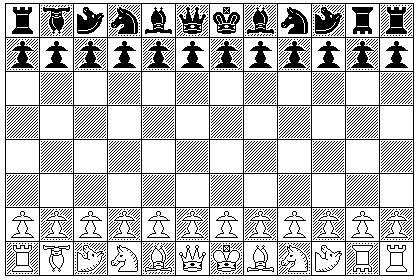
Here, the order of pieces in the back row is:
Rook, Princess, Camel, Knight, Bishop, Queen, King, Bishop, Knight, Camel, Empress, Rook
So now we have the Camel, without the Giraffe, padding a 10 by 8 version of the game to fit a 12 by 8 board! So I seem to be incorrigible here in treating the 12 by 8 board as an end in itself! But it is actually a means to an end - the goal being to have a board that supports the variants that have yet to be described, the ones that will be added below.
This variant, having two additional powerful pieces present, may lead to shorter games than regular Chess, making it a less profound game. So the Camel actually plays an important role; it reduces the average strength of each piece, and by making the board and the complement of forces larger, it will somewhat act to counterbalance the tendency to a shorter game.
Third is a variant which focuses on introducing additional pieces that add new things for the players to think about when they play:

The order of pieces in the back row is:
Rook, Tiger, Cannon, Man, Tiger, Knight, Bishop, Queen, King, Bishop, Knight, Rook
Since the Tiger and Cannon, unlike the Princess, Empress, Camel, and Giraffe, can't jump over the Pawns in front of them (except when capturing), they've all been put on the Queenside of the board so as to allow King-side Castling to retain its full benefit.
The Cannon, with its dependency on a "screen" to capture, works differently from any piece in conventional Chess. A pair of Tigers on opposite colors changes to a pair on the same color of square after a capture, which adds a small strategical concern to every second capture with a Tiger of an unusual kind.
Fourth is a variant aimed at resembling the various versions of Great Chess that were played in the late mediaeval period:

Here, the order of pieces in the back row is:
Rook, Giraffe, Princess, Knight, Bishop, Queen, Griffin, Man, King, Bishop, Knight, Rook
This variant throws caution to the winds when it comes to the power of the pieces on the board. Without adding pieces to the set, a more authentic mediaeval feel to the game can be obtained by treating the Queen as a Fers (able to move only one square diagonally) and the Bishop as an Alfil (able to move only exactly two squares diagonally), and the Man as a Wazir (able to move only one square orthogonally), thus bringing about a fifth variant.
Thus, the idea is to provide as standard a set of variants of Chess that will suit every taste; a variant much the same as Chess as we have it now, one which adds two powerful pieces in a way that has often been proposed, one that brings novel ideas to the game, and one that puts more power on the board for a ferocious battle.
In all these variants, the King moves two squares, and the Rook leaps over it, when Castling, and the Pawn may move two squares on its first move, and be subject to en passant capture if it does, just as in Chess as we know it.
But there is another difference between these variants and regular Chess besides the enlarged board and pieces with new moves.
The scoring of games is changed in a much-simplified version of my concept of Dynamic Scoring.
A draw gives 1/2 point to each player, and a checkmate gives the full 1 point to the player who checkmated his opponent, with the loser getting 0 points.
But stalemate is not a draw.
If White stalemates Black, White receives 3/5 of the game point, and Black recieves 2/5 of the game point. Note that this means that a stalemate is only worth 1/5 as much as a checkmate, so it is still to be avoided if possible.
If Black stalemates White, however, Black recieves 7/10 of the game point, and White recieves 3/10 of the game point. So for Black, stalemates are worth twice as much, 2/5 as much as a checkmate - still less than half the value of a checkmate, though, so it's also important for Black not to blunder a checkmate down to a stalemate.
This is intended to reduce the number of draws, and give Black an incentive to play for an advantage - one sufficient to force stalemate, if not checkmate.
Finally, a chess set which includes a variety of pieces, not all of which are in use at one time, suggests using it for some form of Random Variant Chess. Hence, I've tried to come up with a very simplified version of that, so as to make widespread adoption at least potentially possible.
Thus, I propose that three ordinary identical dice will be used to select a variant.
If all three numbers are identical, this indicates that the variant will be based on the first variant shown above:
1-1-1 The first variant, as shown 2-2-2 The Queen is replaced by the Griffin 3-3-3 The Queen is replaced by an Amazon (Queen) 4-4-4 The Queen is replaced by an Empress 5-5-5 The Queen is replaced by a Camel Empress (Empress) 6-6-6 The Queen is replaced by a Giraffe Empress (Empress)
The Amazon moves as a Queen or a Knight; that is, as a Rook, a Bishop, or a Knight. It still does not have the moves of the Camel or the Giraffe.
The Camel Empress moves as a Camel or a Rook.
The Giraffe Empress moves as a Giraffe or a Rook.
Some of the variants include pieces other than those provided in the set; above, in parentheses, are the recommended physical pieces to use to represent them, just as the Queen, the Bishop, and the Man can still be used in the fifth variant to represent the Fers, the Alfil, and the Wazir.
If two dice form a pair with the same number, but the third is different, the variant will be based on the fourth and fifth variants shown above:
The two dice that show the same number will determine how the Princess, the Bishop, and the Man move:
1-1 Princess, Bishop, Man 2-2 Giraffe Princess, Bishop, Man 3-3 Cannon, Bishop, Man 4-4 Princess, Alfil, Wazir 5-5 Giraffe Princess, Alfil, Wazir 6-6 Cannon, Alfil, Wazir
Since the array for the fourth and fifth variants only included one Princess, replacing it by a Camel Princess, which can move on squares of only one color, is not an option.
The number on the remaining die determines what replaces the Queen:
1 Queen 2 Griffin 3 Empress 4 Aanca (Griffin) 5 Fers (Queen) 6 [One of the above, as indicated by the pair]
Again, the recommended physical piece to use is shown in parentheses.
When the remaining die shows a 6, then the number on the pair of dice with the same number is used to pick a choice from 1 to 5 above instead.
The Aanca, as used in this game, has a move that is basically the reverse of that of the Griffin:
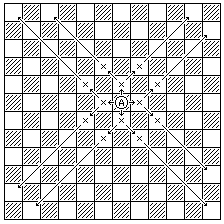
First, it moves one step orthogonally; then, changing its direction by 45 degrees, it moves two or more steps diagonally.
This name for this piece, and maybe the piece itself as well, was invented by Ralph Betza - it was the original Spanish name for the piece we now call the Griffin - for a web page on Bent Riders on the Chess Variant Pages.
When all three numbers on the three dice are different, the variant chosen may be based on either the second or the third variant shown above.
If the dice show three consecutive numbers, then the variant is based on the second one shown above.
1-2-3 The second variant, as shown 2-3-4 The Princess and Empress are replaced by a Giraffe Princess and a Giraffe Empress respectively 3-4-5 The Queen is replaced by a Griffin 4-5-6 The Queen is replaced by a Fers, and the Bishops are replaced by Alfils
In the remaining cases, the variant is based on the third one shown above.
If the lowest number is a 1, and the highest number is a 6, then the Queen is replaced, as follows:
1-2-6 Griffin 1-3-6 Empress 1-4-6 Aanca (Griffin) 1-5-6 Fers (Queen)
If the lowest and highest numbers are 1 and 5, or 2 and 6, respectively, the possibilities where they differ by four, then the Tigers and the Cannon are replaced, as follows:
Highest and lowest number, giving the replacement for the Tiger:
1 5 Tiger 2 6 Camel
Middle number, giving the replacement for the Cannon:
2 or 5 Cannon 3 Princess 4 Aanca (Griffin)
Thus, in this group, the combination 1-2-5 provides the third variant in its original form.
If the lowest and highest numbers are 1 and 4, 2 and 5, or 3 and 6 respectively, the possibilities that differ by three, then the Cannon and the Man are replaced, as follows:
Highest and lowest number, giving the replacement for the Cannon:
1 4 Cannon 2 5 Princess 3 6 Aanca (Griffin)
Middle number, giving the replacement for the Man:
2 or 4 Wazir (Empress) 3 or 5 Giraffe
Random Variant Chess can be used for serious tournaments and matches as a means of making the game less about opening preparation.
It is intended that when a variant is chosen randomly, each player will be able to play in that variant twice, once as White and once as Black, so it will be used for two games in a match, and two rounds in a tournament.
To give all players a more equal opportunity both to be the first to play a variant as White, and to play White instead of Black, it is proposed that colors be alternated in this fashion:
A B V ------ W B 1 B W 1 B W 2 W B 2 W B 3 B W 3 B W 4 W B 4
That is: colors alternate before even-numbered games or rounds, chess variants are selected randomly before odd-numbered games or rounds.
Thus, in a match, Player A would have played White the same number of times as Player B after games 2, 4, 6 and 8; after games 1 and 5, player A would have played White one more time than player B; after games 3 and 7, player B would have played White one more time than player A.
Thus a complete balance is achieved as far as one is possible.
If one is selling a chess set with a 12 by 8 board, with the intent of offering it as a board on which a great many chess variants might be played, one obvious variant to make available would be Courier Chess:
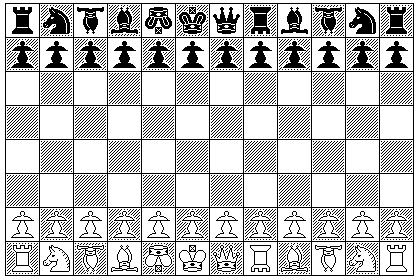
The pieces in the back row of this game are:
Rook, Knight, Alfil, Courier (moves as a Bishop), Man, King, Fers, Sneak (moves as a Wazir), Courier, Alfil, Knight, Rook.
In the variants above, either the modern Bishop or the original Alfil is present, but not both. This in itself is not an insuperable obstacle; I envisage that, to make it simple to remember the new pieces in the set, they will look like this:
Camel Smaller Knight, on a taller pedestal Giraffe Even smaller yet Knight, on an even taller pedestal Princess Smaller Bishop, on a taller pedestal Empress Smaller Rook, on a taller pedestal Cannon Even smaller yet Rook, on an even taller pedestal Man Smaller King, on a taller pedestal Griffin Plain piece, looking like a Pawn, but as tall as a Queen Tiger Rook-sized Pawn on a taller pedestal
So the piece normally used for the Princess would be an obvious choice to represent the Alfil. However, the set only calls for one Princess.
This means that a modification is required; a second Princess is needed in the set.
Also, the fourth alternative was designed in keeping with some other chess variants I've designed, so as to keep King-side Castling unchanged.
But it might be preferable to keep more of the flavor of classic Great Chess variants, with an arrangement of pieces like this instead:
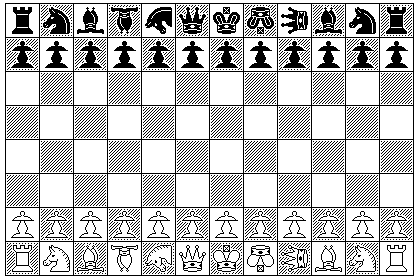
Here, the order of pieces in the back row is:
Rook, Knight, Bishop, Princess, Giraffe, Queen, King, Man, Griffin, Bishop, Knight, Rook